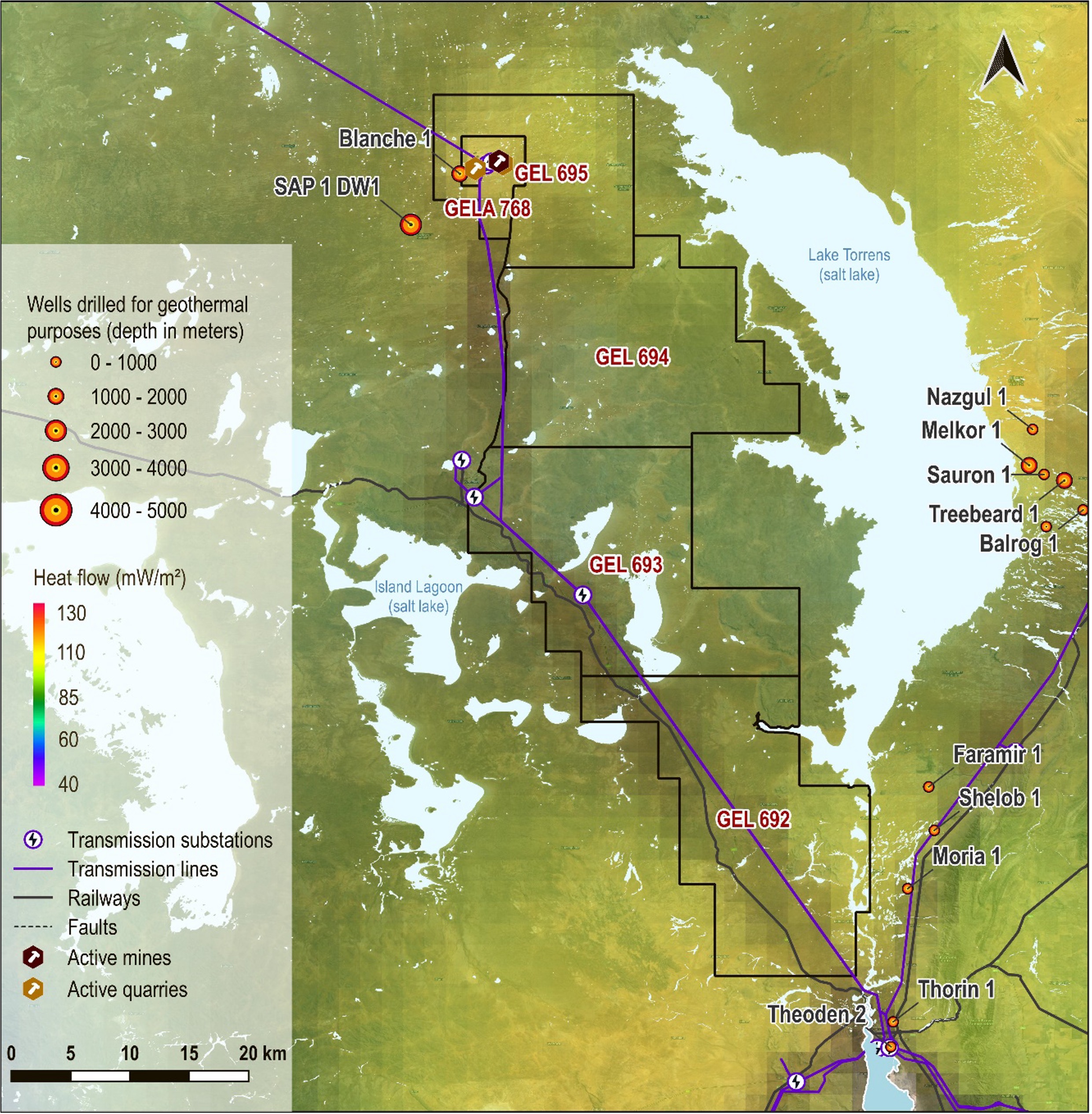PROJECTs
Flinders West
Clean Renewable Geothermal energy in Australia.
Existing well drilled to 1,934m depth with a reservoir temperature of 85.3°C
Excellent Grid Access with Grid Services potential
CCS Exploration and Development Potential
Next Generation Geothermal Production Potential
about
Earth’s Energy Flinders West is a promising geothermal site, drilled to 1,934m with a temperature of 85°C and a high gradient of 43°C per km of depth. It offers excellent grid access and potential for Enhanced Geothermal Systems (EGS) and carbon capture. Analogous US projects confirm its scalability, with future plans for subsurface exploration and leveraging next-generation engineering potentially beyond EGS and AGS.
history
In the early 2000s, the growing interest in renewable energy led to initial investigations of the geothermal potential in the Flinders West Corridor. In 2005, Green Rock secured GELs over the area surrounding the Olympic Dam mine and drilled Blanche 1.
Blanche 1 reached a terminal depth of 1,934m below ground level and reported the following:
- 718m sedimentary rock cover,
- Geothermal gradient estimated to 43°C per km of depth,
- Underlying the sedimentary rock is the crystalline basement composed of fractured granitic rocks (Gawler Craton, 1,217m thick), geothermal gradient estimated to 30°C per km, and
- Measured maximum downhole temperature was 85.3°C at 1,934m.
The exploratory surveys and drilling completed to date across the northern GELs 695 and 768 suggest the potential for an Enhanced Geothermal System (EGS) project. The extrapolated depth to 150°C (necessary for power generation) is ~3.5 km suggesting some potential for an engineered geothermal system project using stimulated horizontal well pairs as pioneered by US operations in Nevada. However, these Nevada wells are ~2.5 km and ~175°C, as a result, additional work will be needed to demonstrate viable economics for an EGS project in the Flinders West Corridor.
Simultaneously, other companies were awarded surrounding GELs, along the western shoreline of Lake Torrens southward to Port Augusta. Exploration activities in that area focused on acquiring temperature and thermal conductivity (TC) data from mineral drillholes, which reported geothermal gradients between 30°C and 40°C per km, and a sedimentary cover of >1,000m across the southern GELs 692, 693 and 694.


Next Generation Geothermal Power Production Potential
Flinders West shows early signs of suitability for other Next Generation Geothermal Power production innovations beyond EGS and AGS. The Company is also assessing the suitability of new plant and systems designs such as supercritical carbon dioxide (sCO2) systems that utilize liquid CO2 instead of H2O as the fluid circulating in the geothermal reservoir to excavate heat. These designs are in early development but are being progressed and developed by multiple highly reputable engineering firms around the globe.
Captured Carbon Storage Potential
Low TC sedimentary units (such as Tregolana Shale and Tapley Hill Formation) can act as an insulator / a low permeability caprock with potential for exploration and development of CO2 subsurface storage should a suitable reservoir be identified in future exploration work in the underlying sandstone or fractured basement.
Flinders West Corridor Analogues from the US
| Name | Location | Installed Capacity | Annual Production |
| Steamboat Hills | Nevada, USA | 84 MW | 252 GWh |
| East Mesa | California, USA | 93 MW | 301 GWh |
| San Emidio | Nevada, USA | 11.8 MW | 94.7 GWh |
| Raft River | Idaho, USA | 18 MW | 100.8 GWh |
Source: US Energy Information Administration, US Federal Energy Regulatory Commission, United States Geological Survey via www.gridinfo.com
The above illustrates US based operating geothermal projects analogous to the Flinders West Corridor based on shared heat characteristics and power densities. The potential for non-linear annual power output relative to the project’s installed capacity is further highlighted by the annual production of GWhs by the San Emidio and Raft River projects.
NEXT STEPS
- Identify and appoint appropriate subsurface exploration team for CCS and geothermal development
- Progress assessment and discussions regarding grid access and grid services along the Flinders West Corridor
- Continue techno-economic assessment of new technologies and engineering such as Next Generation Geothermal Power Production
- Assess potential joint venture opportunities
Subscribe to
announcements
